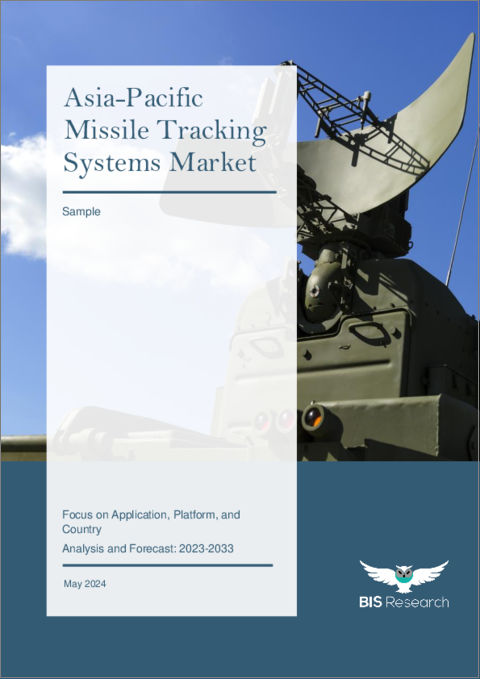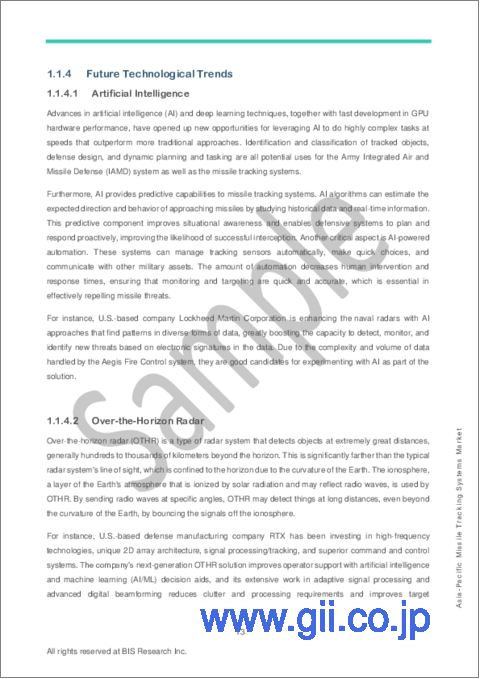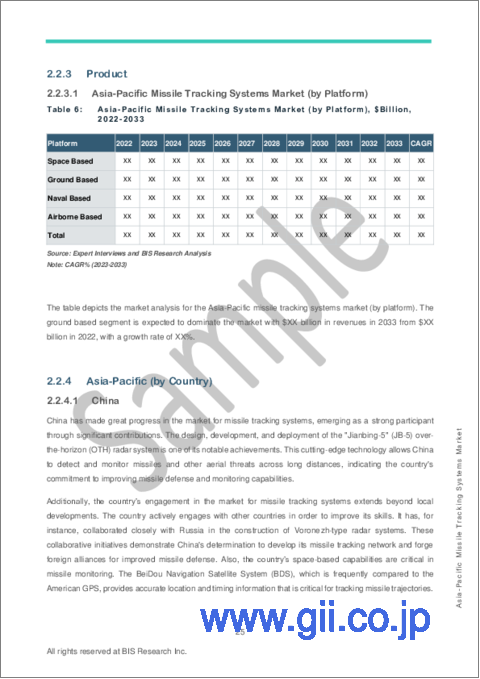|
|
市場調査レポート
商品コード
1477897
アジア太平洋のミサイル追跡システム市場:用途別、プラットフォーム別、国別:分析と予測(2023年~2033年)Asia-Pacific Missile Tracking Systems Market: Focus on Application, Platform, and Country - Analysis and Forecast: 2023-2033 |
||||||
カスタマイズ可能
|
|||||||
| アジア太平洋のミサイル追跡システム市場:用途別、プラットフォーム別、国別:分析と予測(2023年~2033年) |
|
出版日: 2024年05月13日
発行: BIS Research
ページ情報: 英文 68 Pages
納期: 1~5営業日
|
全表示
- 概要
- 図表
- 目次
アジア太平洋のミサイル追跡システムの市場規模は、2023年の153億9,000万米ドルから2033年には278億1,000万米ドルに達し、予測期間の2023年~2033年のCAGRは6.09%になると予測されています。
この成長は、ミサイル追跡の精度と速度を向上させる上で、人工知能と機械学習の組み込みが果たす重要な役割に起因しています。この統合により、脅威のリアルタイム識別と迎撃が可能になります。さらに、極超音速ミサイルのような高度な脅威の拡散は、より弾力性のあるミサイル追跡システムの進歩に拍車をかけており、ハードウェアとソフトウェアの両方の要素において継続的な技術革新が必要となっています。
| 主要市場統計 | |
|---|---|
| 予測期間 | 2023年~2033年 |
| 2023年の評価額 | 153億9,000万米ドル |
| 2033年予測 | 278億1,000万米ドル |
| CAGR | 6.09% |
アジア太平洋(APAC)のミサイル追跡システム市場は、いくつかの重要な要因によって顕著な成長を遂げています。人工知能と機械学習の統合により、ミサイル追跡の精度と速度が大幅に向上し、リアルタイムの脅威識別と迎撃が可能になっています。同地域では極超音速ミサイルやその他の高度な脅威が拡散しているため、より強固なミサイル追跡システムが急務となっています。その結果、防衛機関やメーカーは、新たな脅威に効果的に対抗するため、高度な追跡技術の開発に投資しています。さらに、中国、インド、日本、韓国のような国々における防衛予算の増加は、地政学的緊張と相まって、APAC地域における最先端のミサイル追跡システムの需要を促進しています。このことは、同地域の防衛ニーズの高まりと技術進歩を利用しようとする市場関係者にとって、有利な機会を提供しています。
当レポートでは、アジア太平洋のミサイル追跡システム市場について調査し、市場の概要とともに、用途別、プラットフォーム別、国別の動向、および市場に参入する企業のプロファイルなどを提供しています。
目次
エグゼクティブサマリー
調査範囲
第1章 市場
- 業界展望
- ビジネスダイナミクス
- ビジネス戦略
第2章 地域
- ミサイル追跡システム市場(地域別)
- アジア太平洋
- 市場
- 応用
- 製品
- アジア太平洋(国別)
第3章 競合ベンチマーキングと企業プロファイル
- 市場シェア分析
- 企業プロファイル
- Hanwha Systems Co., Ltd.
第4章 調査手法
List of Figures
- Figure 1: Asia-Pacific Missile Tracking Systems Market, $Billion, 2022-2033
- Figure 2: Share of Missile Tracking Systems Market (by Region), $Billion, 2033
- Figure 3: Cost Analysis by Platform
- Figure 4: Asia-Pacific Missile Tracking Systems Market (by Application), $Billion, 2023 and 2033
- Figure 5: Market Share Analysis, by Space-based Missile Tracking Systems Platform
- Figure 6: Missile Tracking Systems Value Chain
- Figure 7: Missile Tracking Systems Market, Business Dynamics
- Figure 8: Share of Key Business Strategies and Developments, January 2021- October 2023
- Figure 9: Missile Tracking Systems Market in Defense Share (by Company), 2022
- Figure 10: Missile Tracking Systems Market in Defense Share (by Company),2022
- Figure 11: Missile Tracking Systems Market in Defense Share (by Company),2022
- Figure 12: Missile Tracking Systems Market in Defense Share (by Company),2022
- Figure 13: Research Methodology
- Figure 14: Top-Down and Bottom-Up Approach
- Figure 15: Assumptions and Limitations
List of Tables
- Table 1: Category of Missile Tracking Systems Platform Manufacturers
- Table 2: Missile Tracking Systems Platform Manufacturers' Developments
- Table 3: Category of Payload/Component Facilitators
- Table 4: Partnerships, Collaborations, Agreements, and Contracts, January 2021-October 2023
- Table 5: Market Developments, January 2021-October 2023
- Table 6: Missile Tracking Systems Market (by Region), $Billion, 2022-2033
- Table 7: Asia-Pacific Missile Tracking Systems Market (by Application), $Billion, 2022-2033
- Table 8: Asia-Pacific Missile Tracking Systems Market (by Platform), $Billion, 2022-2033
- Table 9: China Missile Tracking Systems Market (by Application), $Billion, 2022-2033
- Table 10: China Missile Tracking Systems Market (by Platform), $Billion, 2022-2033
- Table 11: Japan Missile Tracking Systems Market (by Application), $Billion, 2022-2033
- Table 12: Japan Missile Tracking Systems Market (by Platform), $Billion, 2022-2033
- Table 13: India Missile Tracking Systems Market (by Application), $Billion, 2022-2033
- Table 14: India Missile Tracking Systems Market (by Platform), $Billion, 2022-2033
- Table 15: Rest-of-Asia-Pacific Missile Tracking Systems Market (by Application), $Billion, 2022-2033
- Table 16: Rest-of-Asia-Pacific Missile Tracking Systems Market (by Platform), $Billion, 2022-2033
- Table 17: Hanwha Systems Co., Ltd.: Product Portfolio
- Table 18: Hanwha Systems Co., Ltd.: Partnerships, Collaborations, Agreements, and Contracts
Introduction to Asia-Pacific Missile Tracking Systems Market
The Asia-Pacific missile tracking systems market is projected to reach $27.81 billion by 2033 from $15.39 billion in 2023, growing at a CAGR of 6.09% during the forecast period 2023-2033. The growth can be attributed to the vital role played by the incorporation of artificial intelligence and machine learning in enhancing the precision and velocity of missile tracking. This integration enables the real-time identification and interception of threats. Additionally, the proliferation of advanced threats like hypersonic missiles has spurred the advancement of more resilient missile tracking systems, necessitating ongoing innovation in both hardware and software elements.
| KEY MARKET STATISTICS | |
|---|---|
| Forecast Period | 2023 - 2033 |
| 2023 Evaluation | $15.39 Billion |
| 2033 Forecast | $27.81 Billion |
| CAGR | 6.09% |
Market Introduction
The Asia-Pacific (APAC) missile tracking systems market is experiencing notable growth driven by several key factors. The integration of artificial intelligence and machine learning has significantly enhanced missile tracking accuracy and speed, enabling real-time threat identification and interception. With the proliferation of hypersonic missiles and other sophisticated threats in the region, there is a pressing need for more robust missile tracking systems. As a result, defense agencies and manufacturers are investing in the development of advanced tracking technologies to counter emerging threats effectively. Moreover, increasing defense budgets in countries like China, India, Japan, and South Korea, coupled with geopolitical tensions, are driving the demand for state-of-the-art missile tracking systems in the APAC region. This presents lucrative opportunities for market players aiming to capitalize on the region's growing defense needs and technological advancements.
Market Segmentation:
Segmentation 1: by Application
- Target Acquisition
- Air Defense
- Space Domain Awareness
- Early Warning Capabilities
Segmentation 2: by Platform
- Space-Based Missile Tracking Systems
- Ground-Based Missile Tracking Systems
- Naval-Based Missile Tracking Systems
- Airborne-Based Missile Tracking Systems
Segmentation 3: by Country
- Japan
- India
- China
- Rest-of-Asia-Pacific
How can this report add value to an organization?
Product/Innovation Strategy: The product segment helps the reader understand the different types of products available for deployment and their potential. Moreover, the study provides the reader with a detailed understanding of the missile tracking systems market by application on the basis of application (target acquisition, air defense, space domain awareness, and early warning capabilities) and product on the basis of platform (space-based missile defense systems, ground-based missile defense systems, naval-based missile defense systems, and airborne-based missile defense systems).
Growth/Marketing Strategy: The Asia-Pacific missile tracking systems market has seen major development by key players operating in the market, such as business expansion, partnership, collaboration, and joint venture. The favored strategy for the companies has been partnerships and contracts to strengthen their position in the missile tracking systems market.
Competitive Strategy: Key players in Asia-Pacific the missile tracking systems market analyzed and profiled in the study involve major missile tracking systems offering companies providing missile tracking systems for the purpose. Moreover, a detailed competitive benchmarking of the players operating in the missile tracking systems market has been done to help the reader understand how players stack against each other, presenting a clear market landscape. Additionally, comprehensive competitive strategies such as partnerships, agreements, and collaborations will aid the reader in understanding the untapped revenue pockets in the market.
Table of Contents
Executive Summary
Scope of the Study
1 Market
- 1.1 Industry Outlook
- 1.1.1 Missile Tracking Systems Market: Overview
- 1.1.2 Evolving Missile Tracking Technologies in the Defense Industry
- 1.1.3 On-going and Upcoming Programs
- 1.1.3.1 Hypersonic and Ballistic Tracking Space Sensor (HBTSS)
- 1.1.3.2 Proliferated Warfighter Space Architecture (PWSA)
- 1.1.4 Future Technological Trends
- 1.1.4.1 Artificial Intelligence
- 1.1.4.2 Over-the-Horizon Radar
- 1.1.5 Value Chain Analysis
- 1.2 Business Dynamics
- 1.2.1 Business Drivers
- 1.2.1.1 Geopolitical Conflicts and Tensions
- 1.2.1.2 Emerging Hypersonic Armament Capabilities
- 1.2.1.3 Replacement of Legacy Systems
- 1.2.2 Business Challenges
- 1.2.2.1 Advancements in Stealth Technologies
- 1.2.2.2 Complex Sensor Integration
- 1.2.2.3 Efficient Data Transmission
- 1.2.3 Business Opportunities
- 1.2.3.1 AI and ML Integration
- 1.2.3.2 Directed Energy Weapons
- 1.2.1 Business Drivers
- 1.3 Business Strategies
- 1.3.1 Partnerships, Collaborations, Agreements, and Contracts
- 1.3.2 Market Developments
2 Region
- 2.1 Missile Tracking Systems Market (by Region)
- 2.2 Asia-Pacific
- 2.2.1 Market
- 2.2.1.1 Key Manufacturers in Asia-Pacific
- 2.2.1.2 Business Drivers
- 2.2.1.3 Business Challenges
- 2.2.2 Application
- 2.2.2.1 Asia-Pacific Missile Tracking Systems Market (by Application)
- 2.2.3 Product
- 2.2.3.1 Asia-Pacific Missile Tracking Systems Market (by Platform)
- 2.2.4 Asia-Pacific (by Country)
- 2.2.4.1 China
- 2.2.4.1.1 Market
- 2.2.4.1.1.1 Key Manufacturers in China
- 2.2.4.1.2 Application
- 2.2.4.1.2.1 China Missile Tracking Systems Market (by Application)
- 2.2.4.1.3 Product
- 2.2.4.1.3.1 China Missile Tracking Systems Market (by Platform)
- 2.2.4.1.1 Market
- 2.2.4.2 Japan
- 2.2.4.2.1 Market
- 2.2.4.2.1.1 Key Manufacturers in Japan
- 2.2.4.2.2 Application
- 2.2.4.2.2.1 Japan Missile Tracking Systems Market (by Application)
- 2.2.4.2.3 Product
- 2.2.4.2.3.1 Japan Missile Tracking Systems Market (by Platform)
- 2.2.4.2.1 Market
- 2.2.4.3 India
- 2.2.4.3.1 Market
- 2.2.4.3.1.1 Key Manufacturers in India
- 2.2.4.3.2 Application
- 2.2.4.3.2.1 India Missile Tracking Systems Market (by Application)
- 2.2.4.3.3 Product
- 2.2.4.3.3.1 India Missile Tracking Systems Market (by Platform)
- 2.2.4.3.1 Market
- 2.2.4.4 Rest-of-Asia-Pacific
- 2.2.4.4.1 Application
- 2.2.4.4.1.1 Rest-of-Asia-Pacific Missile Tracking Systems Market (by Application)
- 2.2.4.4.2 Product
- 2.2.4.4.2.1 Rest-of-Asia-Pacific Missile Tracking Systems Market (by Platform)
- 2.2.4.4.1 Application
- 2.2.4.1 China
- 2.2.1 Market
3 Competitive Benchmarking and Company Profiles
- 3.1 Market Share Analysis
- 3.2 Company Profiles
- 3.2.1 Hanwha Systems Co., Ltd.
- 3.2.1.1 Company Overview
- 3.2.1.1.1 Role of Hanwha Systems Co., Ltd. in the Missile Tracking Systems Market
- 3.2.1.1.1.1 Product Portfolio
- 3.2.1.1.1 Role of Hanwha Systems Co., Ltd. in the Missile Tracking Systems Market
- 3.2.1.2 Corporate Strategies
- 3.2.1.2.1 Partnerships, Collaborations, Agreements, and Contracts
- 3.2.1.3 Analyst View
- 3.2.1.1 Company Overview
- 3.2.1 Hanwha Systems Co., Ltd.
4 Research Methodology
- 4.1 Factors for Data Prediction and Modeling





